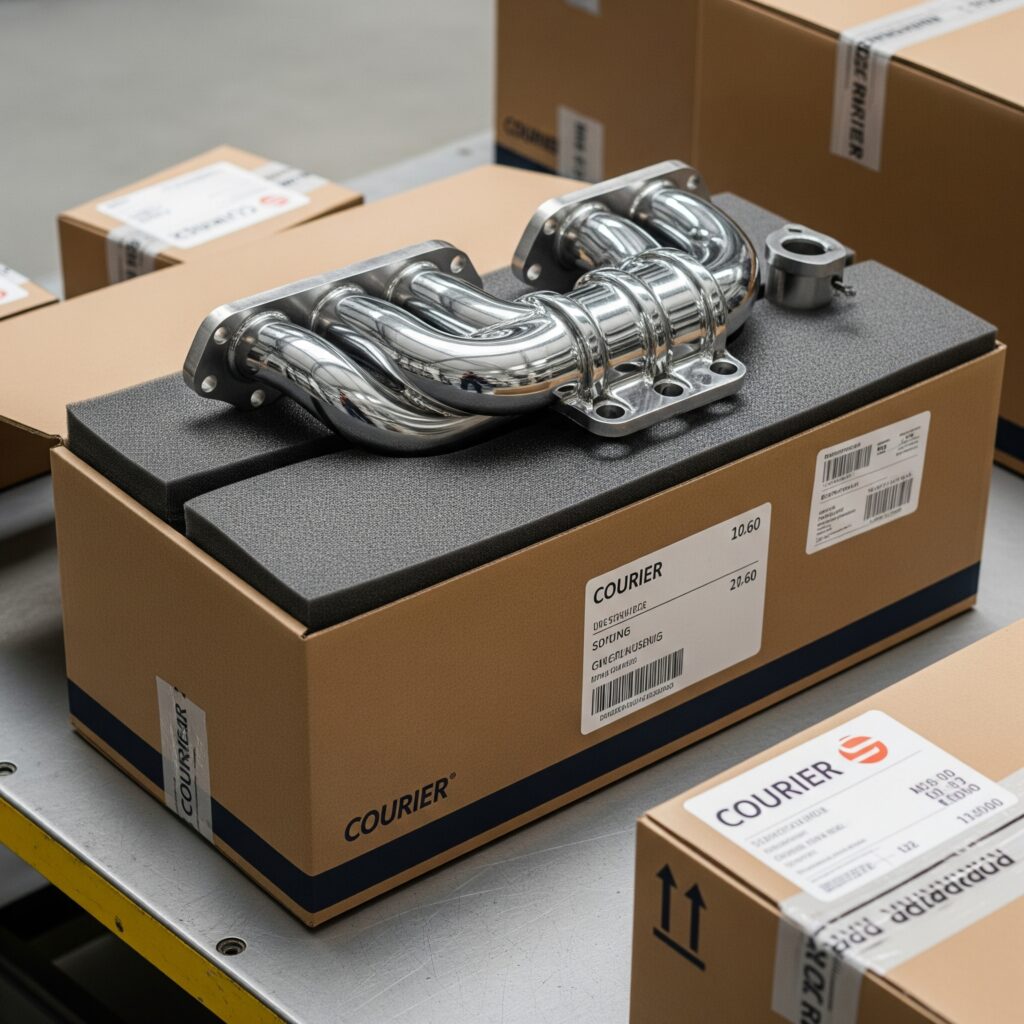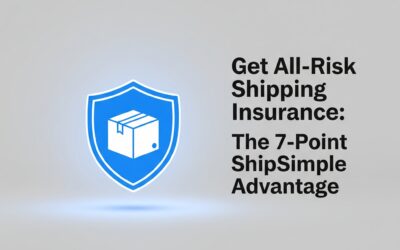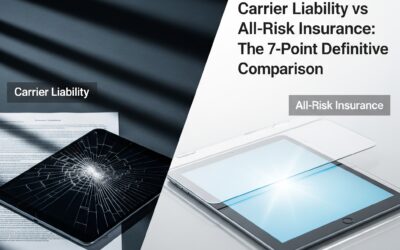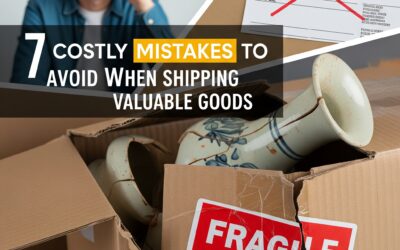You’re past the initial discovery phase. You’ve recognized the undeniable, high-stakes risk that comes with shipping automotive parts in today’s complex logistics environment. You know that sending a meticulously restored classic car, a high-performance engine, or a pallet of mission-critical electronic modules across the country on a simple prayer and a standard shipping label is not a sustainable business strategy. The pivotal question is no longer if you need protection, but rather what kind of protection is truly right for your automotive business. This is the critical evaluation stage, where making an informed choice is paramount.
The market is a minefield of confusing and often misleading terms: carrier liability, declared value, third-party insurance, all-risk coverage, named perils. Choosing the wrong type of coverage can be just as financially devastating as having no coverage at all, leaving you with a false sense of security that evaporates the moment you need it most.
This in-depth guide is built specifically for you-—the savvy automotive professional currently in the middle of the funnel, weighing your options. We will provide a clear, 7-point framework for your automotive shipping insurance comparison. By breaking down the fundamental differences between the types of protection available, this guide will empower you to dissect any insurance offering with confidence, ensuring you select a solution that truly aligns with the high-value, high-stakes nature of your business.

The Landscape of Protection: Understanding Your 3 Core Options
Before we can compare specific features, it’s crucial to understand the three fundamental paths your business can take to manage shipping risk. Each one has vastly different and profound implications for your company’s capital, operational resilience, and overall peace of mind.
Option 1: Standard Carrier Liability (The Default Gamble)
This is the automatic, baseline “coverage” included with virtually all freight and parcel services. However, it’s critical to understand that this is not true insurance. It is simply the carrier’s predetermined, legally mandated limit of liability in the event they are found to be negligent for the loss or damage of your goods. As we will explore, these limits are often shockingly low and the process for making a claim is notoriously difficult. For any business shipping valuable automotive goods, relying on this default option is a significant and often costly gamble.
Option 2: Self-Insurance (The High-Stakes Reserve Fund)
Some larger businesses opt for a strategy of self-insurance. This involves formally setting aside a dedicated pool of the company’s own money-—a “rainy day fund”-—to cover any potential shipping losses or damages that may occur. The primary theoretical advantage is that you are not paying external insurance premiums. However, the disadvantages are substantial. This strategy ties up significant working capital that could otherwise be invested in growth. More importantly, it offers zero protection against catastrophic single events (like the loss of an entire trailer of parts) or a string of multiple, smaller losses in a short period. A single major incident can easily wipe out the entire reserve fund, leaving the business fully exposed.
Option 3: Specialized Third-Party Insurance (The Strategic Safeguard)
The third path is to purchase a dedicated, formal insurance policy from a company whose core business is assessing and managing risk. This is the strategic choice for businesses that want comprehensive, predictable, and expert-backed financial protection. Companies like ShipSimple operate on this model, partnering with major underwriters to offer policies specifically designed to cover the full value of goods in transit. This transforms risk from an unpredictable threat into a manageable and budgetable business expense.

The 7-Point Framework for Your Automotive Shipping Insurance Comparison
Now that we’ve defined the landscape, let’s dive into the critical points of comparison. Use this 7-point framework to evaluate any insurance option you are considering. The differences will be stark, and they will illuminate the clear choice for protecting your valuable automotive assets.
1. Scope of Coverage: “All-Risk” vs. “Named Perils”
This is perhaps the most important-—and often most misunderstood-—distinction in the insurance world. The type of policy determines what is actually covered, and the difference between them is enormous.
The Carrier’s “Named Perils” Trap: Standard carrier liability, and many basic insurance policies, operate on a “Named Perils” basis. This means the policy only covers losses caused by a short, specific list of events or “perils” that are explicitly named in the contract. If your loss is caused by something that isn’t on that list, you are not covered.
Furthermore, with carrier liability, the ultimate “named peril” is proven carrier negligence. You, the shipper, have the burden of proof. You must prove that the carrier’s direct actions or inactions led to the damage. This leaves you exposed to a vast array of common shipping realities that are typically excluded, such as:
- Damage from normal road vibration or shock.
- Concealed damage discovered only after uncrating a component.
- Loss or damage from “Acts of God” (floods, storms, earthquakes).
- Damage attributed to insufficient packaging, even if the carrier’s own guidelines were followed.
- Theft from a secured yard or during a scheduled transit stop.
The Specialist’s “All-Risk” Advantage: In stark contrast, reputable third-party insurers like ShipSimple offer “All-Risk” coverage. This is the gold standard for shipping insurance. An All-Risk policy operates on a simple, powerful premise: every potential risk is covered, unless it is specifically and explicitly excluded in the policy.
This fundamentally shifts the entire dynamic. Instead of you having to prove that a covered event occurred, the insurance company has to prove that the damage was caused by one of the few, clearly defined exclusions (such as acts of war, nuclear events, or improper packaging by the shipper). For the 99.9% of things that can go wrong in transit-—from forklift punctures and water damage to theft and accidental drops-—you are covered.
Automotive Scenario: A pallet of sensitive electronic control units (ECUs) arrives at its destination. Externally, the packaging looks fine. However, upon testing, it’s discovered that the delicate internal circuitry of several units was damaged by excessive vibration during a rough patch of transit.
- Carrier Liability (“Named Perils”): The claim is almost certain to be denied. Vibration is a normal part of shipping, and proving specific negligence that caused this “concealed” damage is nearly impossible.
- Specialized Insurance (“All-Risk”): This is precisely the kind of unforeseen, in-transit event that All-Risk coverage is designed to protect against. The claim would be covered.
➡️ External Link: For a deeper dive, review this definition of All-Risk vs. Named Perils coverage from Investopedia.
2. Payout Value: True Replacement Cost vs. Arbitrary Per-Pound Limits
After the scope of coverage, the next critical question is: “If my claim is approved, how much will I actually be paid?” This is where the financial models of carrier liability and specialized insurance diverge completely.
The Carrier’s Flawed Math: As detailed previously, carriers limit their liability based on an arbitrary formula, most commonly $2 per pound. This model is completely disconnected from the reality of the automotive industry, where value is concentrated in precision engineering, technology, and rarity-—not weight. This creates a dangerous financial exposure for nearly every automotive shipment. The payout you receive is often a tiny, almost insulting fraction of the item’s true worth.
The Specialist’s “Make-Whole” Philosophy: Specialized third-party insurance is built on the principle of “Declared Value.” This means you are insuring your asset for its actual, declared replacement cost. The entire purpose of the policy is to provide you with enough capital to be “made whole” after a loss-—to replace the item, restart the project, and continue business with minimal financial disruption.
Let’s run an automotive shipping insurance comparison with a real-world scenario:
- The Shipment: A pallet containing a rebuilt automatic transmission ($7,500 value, 250 lbs) and a set of four custom alloy wheels ($4,000 value, 120 lbs). Total shipment value: $11,500.
- The Incident: The pallet is lost in a terminal fire.
- Carrier Liability Payout: The total weight is 370 lbs. At $2/lb, the maximum payout is $740. Your business suffers a staggering $10,760 loss.
- Specialized Insurance Payout: Because you declared the full value, the payout would be $11,500, allowing you to replace the items and fulfill your customer’s order.
➡️ Internal Link: See how ShipSimple’s high-value coverage protects your assets for their true worth.
3. The Claims Experience: A Supportive Partner vs. An Adversarial Opponent
When an incident occurs, the last thing you need is a secondary battle with a claims department. The user experience during the claims process is a fundamental differentiator between carriers and specialists.
The Carrier’s Adversarial Process: From a business perspective, a carrier’s primary goal is to move freight. Their claims department often functions as a cost-control center, tasked with minimizing payouts to protect the company’s bottom line. This creates an inherently adversarial relationship. The process is designed to be difficult and place the burden of proof entirely on you. You can expect:
- Lengthy, complex forms and exhaustive documentation requirements.
- A slow, opaque process with little to no proactive communication.
- A high likelihood of the claim being denied on a technicality.
- Weeks or months of waiting for a resolution.
The Specialist’s Service-Oriented Process: A specialized insurer’s business model is fundamentally different. Their core product is the promise of a fair and fast claim resolution. Their goal is to provide the service you paid for, efficiently and effectively. With a modern provider like ShipSimple, you can expect:
- A streamlined digital process: Submit your claim online in minutes with photos and documents.
- White-glove support: A dedicated, human claims advocate is assigned to your case to guide you.
- A focus on speed: The internal goal is to resolve claims in days, not the weeks or months typical of carriers.
Automotive Scenario: Your shipment of a vintage, irreplaceable bumper arrives bent.
- Carrier Claim: You spend hours on paperwork and emails, only to be told weeks later that the packaging was deemed insufficient, and the claim is denied.
- Specialist Claim: You file the claim online before lunch. A claims advocate calls you that afternoon to confirm details. A payout is processed within the week.
➡️ Internal Link: Learn about the simple, supportive ShipSimple claims process here.
4. The True Cost: Unpredictable Disasters vs. Predictable Premiums
Many businesses fall into the trap of viewing carrier liability as “free” and any extra insurance as an unnecessary cost. This is a flawed perspective that ignores the concept of total cost of risk.
The Hidden Costs of “Cheaper” Options: The true cost of relying on insufficient coverage is not zero. It is a massive, unpredictable liability hiding on your balance sheet. The cost is only realized when an incident occurs, and it includes:
- The huge, uninsured portion of the asset’s value.
- The internal administrative hours and resources wasted fighting a claim.
- The cost of expediting a replacement shipment to save a customer relationship.
- The long-term cost of reputational damage.
The Strategic Cost of a Transparent Premium: A specialized insurance premium, in contrast, is a known, predictable, and budgetable business expense. It is a strategic cost that you consciously undertake to completely eliminate an unknown and potentially catastrophic financial risk. By paying a small, fixed premium, you are transforming uncertainty into certainty. This allows for more accurate financial planning and demonstrates sound fiscal management to partners and lenders.
5. Policy Flexibility: Rigid & Uniform vs. Tailored & Custom
The automotive industry is not monolithic. Your business has unique needs, risks, and shipping profiles. Your insurance solution should reflect that.
The Carrier’s Inflexible Box: Carrier liability is the definition of a one-size-fits-all solution. It does not differentiate between a crate of nuts and bolts and a priceless, one-of-a-kind classic car part. The rules are rigid, the limits are set, and there is no room for customization.
The Specialist’s Tailored Solutions: A key advantage of working with a dedicated insurance provider is the ability to create flexible and tailored solutions. This is where a true partner distinguishes themselves. A specialist like ShipSimple can work with you to develop:
- Custom High-Limit Programs: For enterprise-level businesses shipping millions of dollars in goods, standard policies can be adapted to provide higher overall coverage limits.
- Project-Based Coverage: For unique situations like a multi-stage car restoration or a traveling race team, policies can be crafted to cover specific, complex logistical needs.
- Specialized Endorsements: Coverage can be fine-tuned to address unique risks, like insuring against cosmetic damage to a show car.
This flexibility ensures that your coverage actually matches your real-world business operations.
➡️ Internal Link: Explore options for enterprise and custom insurance solutions.
6. Underlying Expertise: Logistics Company vs. Financial Risk Experts
Who would you rather trust to protect your financial assets? A company whose expertise lies in operating trucks and warehouses, or a company whose entire foundation is built on financial risk management?
The Carrier’s Focus: A freight carrier is an expert in logistics. Their teams are skilled in route optimization, warehouse management, and transportation efficiency. They are not, however, experts in financial risk analysis, actuarial science, or insurance underwriting.
The Specialist’s Foundation: A dedicated insurance provider is, by its very nature, a financial services company. Their expertise lies in:
- Accurate Risk Assessment: Understanding and pricing the specific risks associated with different types of goods and transit routes.
- Financial Stability: They are backed by globally recognized, A-rated financial institutions—called underwriters (ShipSimple is partnered with CNA, for example)—which guarantees their ability to pay even the largest claims.
- Regulatory Compliance: Deep knowledge of the complex financial and legal regulations governing the insurance industry.
The analogy holds true: you wouldn’t ask your accountant to fix your car’s engine. It makes little sense to rely on your shipping company for sophisticated financial protection.
7. Business Impact: A Liability on the Books vs. An Asset for Growth
The final point of comparison is the most strategic. How does your choice of insurance impact your company’s culture and its ability to grow?
The Carrier Liability Mindset: Operating under the minimal protection of carrier liability forces a business into a defensive, risk-averse posture. It treats shipping as a constant source of anxiety and a potential liability. This mindset can lead to conservative decision-making, such as turning down opportunities to ship higher-value products or avoiding expansion into new markets for fear of the associated risks.
The Specialized Insurance Mindset: Conversely, having robust, reliable insurance transforms protection from a liability into a strategic asset. Knowing that your shipments are fully protected empowers your business to operate with confidence and agility. It becomes a tool for growth:
- It allows you to pursue high-value clients without fear.
- It gives you the confidence to expand your product offerings into more expensive categories.
- It enables you to offer superior service guarantees to your customers, creating a key competitive advantage.
Ultimately, sound risk management isn’t about preventing a business from taking risks; it’s about giving the business the security it needs to take the right risks to grow.
➡️ External Link: As Forbes notes, effective risk management is a core strategic function that drives better decision-making and builds resilience.
How to Make the Right Choice for Your Automotive Business
Now that we have broken down the 7 key points of an automotive shipping insurance comparison, the path forward should be much clearer. When evaluating your options, use this framework as a checklist. Ask any potential provider these questions:
- Is your coverage “All-Risk” or “Named Perils”?
- Do you cover the full declared replacement value or use arbitrary limits?
- What does your claims process look like, and what is your average resolution time?
- Is your cost a transparent premium, or am I exposed to hidden risks?
- Can you tailor a policy to my specific automotive business needs?
- Is your primary expertise in logistics or in financial risk management?
- Will this solution enable my business to grow confidently?
The answers to these questions will invariably lead you to the conclusion that for any serious business operating in the high-value automotive space, a specialized, third-party insurance provider is the only logical and responsible choice.
Take the Next Step in Your Evaluation
Making the right choice in your automotive shipping insurance comparison is one of the most important strategic decisions you can make to protect your business. The differences in coverage, value, and service are not minor—they are fundamental. Choosing a partner that offers comprehensive all-risk coverage, full replacement value, and a supportive, service-oriented claims process is the only path that truly safeguards your assets, your reputation, and your bottom line.
Feeling more prepared to make a decision? To help you take the next step in your evaluation, we’ve created a simple tool.
➡️ Download our free, one-page “Insurance Comparison Checklist for Automotive Shippers” to objectively score your options and make the right choice for your business.

Additional Resources
- Shipping Insurance Overview
- Automotive Industry Page
- Get a Quote
- How to Package Automotive Parts for Safe Shipping
- Shipping Insurance FAQs
- Freight Insurance for Aerospace & Aviation
- Automotive Logistics – Supply Chain Management
- Transport Canada – Motor Vehicle Safety
- Auto Care Association
- SEMA (Specialty Equipment Market Association)
- Red Stag Fulfillment – How to Ship Car Parts




